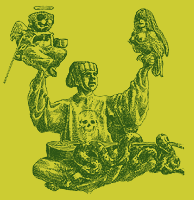On the Album:
The Transfiguration of Blind Joe Death is John Fahey's classic fifth album from the mid-1960s and is one of his most influential. John created the concept of the solo steel-string guitar composer in the late 1950s and he has been a huge influence on other solo guitarist/composers including Bob Brozman, Leo Kottke, Peter Lang, Dale Miller, Will Ackerman, Bob Hadley, Woodty Mann, Woody Harris, Toulouse Englehart, and many others. This album has an amazing variety of styles, moods, and influences, and John has a compositional and playing style that is totally unique. Peter Lang expressed it to me very well when he said that one of John Fahey's great attributes is using dissonance as melody.
On the tunings:
His tunings include standard tuning {E-A-D-G-B-E, from the lowest pitched string to the highest}, dropped D tuning {D-A-D-G-B-E}, open G major {D-G-D-G-B-D}, open G minor {D-G-D-G-Bflat-D}, open D major {D-A-D-Fsharp-A-D}, open D minor {D-A-D-F-A-D}, D modal {D-A-D-G-A-D}, open C major {C-G-C-G-C-E}, and a drone open C {C-G-C-G-C-C} used for the Indian raga - influenced pieces he recorded on other albums. For slide guitar, which he plays flat on his lap Hawaiian-style, he plays in open G major, open G minor, an open G drone tuning he invented {D-G-D-G-G-D}, open D major, and an open C major tuning he invented {C-C-C-G-C-E, with the lowest three pitched strings tuned to the same note}, which is used most notably on the song "Dance of the Inhabitants of King Phillip XIV of Spain," on his Takoma album Death Chants, Breakdowns and Military Waltzes.
On the prolific Fahey:
John has made more albums than I can count (about 35 to date on Takoma, Vanguard, Verrik/Rounder, Warner/Reprise, and Shanachie) and he's still making good ones.
On appreciation:
Some of you may be aware that there is a great organization called the Chet Atkins Appreciation Society - I think that there should also be a John Fahey Appreciation Society.
- George Winston, 1996
Excerpts from Samuel Charters notes to the 1968 Takoma reissue:
It was during this period that John's concept of composition within the form of an extended improvisation was most influential, especially in San Francisco. The group Country Joe and the Fish was the most successful of the bands that had absorbed some of his ideas, but it had already become part of the style of the music developing there. It was about this time that I first started seeing hand-printed notices thumbtacked on the walls in university buildings. They read something like, "Twenty-two-year-old grad student wants to meet girl for talk and exchanges and hiking. Into Zen, rock, and John Fahey."
This album, The Transfiguration of Blind Joe Death, comes roughly in the middle of John's recorded work, most of it from close to the end of the sixties, though the material was assembled from a number of tapes. It was originally released in the United States by a small Boston record distributor called Riverboat. Although it comes at the point when he was beginning to think of more extended forms it's very much in the style of the first Takoma albums and could be thought of as a continuation of the concepts he was working with then. ... this album is important for what it sums up of the work he had already done in the first years he had been recording, and also for what it suggests of the changes and the developments that were to come.
~ Samuel Charters, 1968
